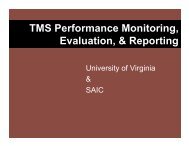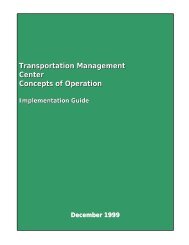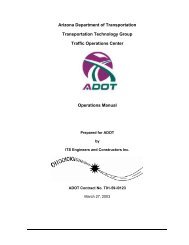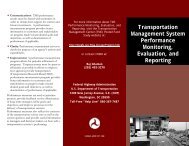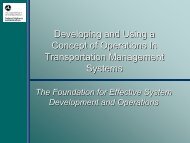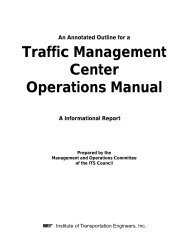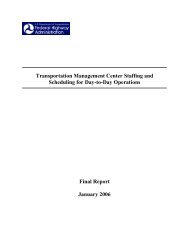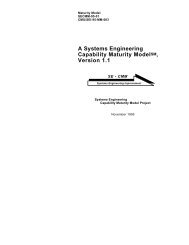Conference Proceedings 26 - Transportation Research Board
Conference Proceedings 26 - Transportation Research Board
Conference Proceedings 26 - Transportation Research Board
- No tags were found...
Create successful ePaper yourself
Turn your PDF publications into a flip-book with our unique Google optimized e-Paper software.
174 PERFORMANCE MEASURES TO IMPROVE TRANSPORTATION SYSTEMS AND AGENCY OPERATIONSplanning, contributions to economic development,air quality improvements, or other goals that may beimportant to the agency. Moreover, several aspects ofquality of service are not measured in performancereviews. These aspects include vehicle cleanliness andcomfort; operator courtesy; on-time performance;quality of marketing and passenger information support;and level of satisfaction with hours of operations,frequency of service, and geographic coverageof the service.In addition to the understanding of the limits ofthis analysis, use caution when interpreting the meaningof the various measures. The performance reviewdoes not necessarily provide information regardingwhich aspects of performance are within control ofthe agency and which measures are not. Factors thataffect transit performance are included in Figure 4.Performance reviews are useful and importanttools in monitoring and improving transit system performance.However, it should be recognized that theresults of trend and peer analyses are only a startingpoint for fully understanding the performance oftransit systems. The issues identified as a result of theanalyses provide the basis for a series of questions,which can lead to an enhanced understanding of thehows and whys of system performance.Performance Indicators and Measures The evaluationmeasures used throughout the performance revieware composed of three major categories: generalperformance indicators, effectiveness measures, andefficiency measures. General performance indicatorsreport the data in the selected categories that are requiredby NTD reporting. They tend to be key indicatorsof overall transit system performance. Effectivenessmeasures typically refine the data further andindicate the extent to which various service-relatedgoals are achieved. For example, passenger trips percapita is an indicator of the effectiveness of theagency in meeting transportation needs. Efficiencymeasures involve reviewing the level of resources (laboror cost) required to achieve a given level of output.It is possible to have very efficient service that isnot effective or to have highly effective service thatis not efficient. Similarly, the service can be both efficientand effective or inefficient and ineffective inattaining a given objective.The substantial amount of data available throughNTD reporting provides an opportunity to develop alarge number of measures. Sets of general performanceindicators, effectiveness measures, and efficiencymeasures have been selected on the belief thatthey provide a good representation of overall transitsystem performance. Other measures and categorizationsmay be developed with the same data. Table4 lists the indicators and measures used for directlyoperated transit services and provides subcategorieswhen appropriate. The extensive list of indicatorsand measures provides a voluminous amount of data,all of which are required to fully understand the performanceof a transit system.Peer Selection ProcessThe methodology for the selection of peer systems forthe statewide peer review is relatively straightforward.Selection of peer systems is based foremost ongeographic location. Specifically, peer groups are chosenfrom the 12 southeastern states, as shown in Figure5.FIGURE 4Factors affecting transit performance.



